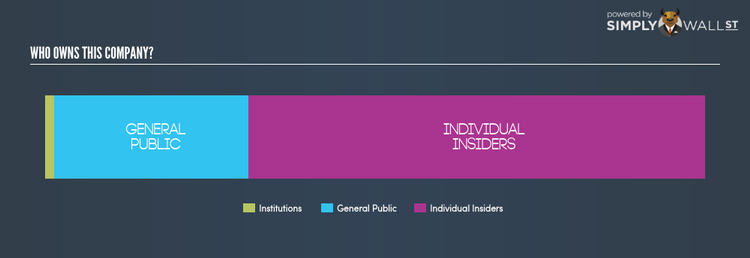Should You Be Concerned About Ability Inc’s (NASDAQ:ABIL) Investors?

In this article, I will take a quick look at Ability Inc’s (NASDAQ:ABIL) recent ownership structure – an unconventional investing subject, but an important one. The impact of a company’s ownership structure affects both its short- and long-term performance. Differences in ownership structure of companies can have a profound effect on how management’s incentives are aligned with shareholder returns, which is why we’ll take a moment to analyse ABIL’s shareholder registry.
Check out our latest analysis for Ability
Institutional Ownership
Institutional investors typically buy and sell shares in large magnitudes which can significantly sway the share price, especially when there are relatively small amounts of shares available on the market to trade. A low institutional ownership of 1.44% puts ABIL on a list of companies that are not likely exposed to spikes in volatility resulting from institutional trading.
Insider Ownership
I find insiders are another important group of stakeholders, who are directly involved in making key decisions related to the use of capital. In essence, insider ownership is more about the alignment of shareholders’ interests with the management. 69.08% ownership of ABIL insiders is large enough to make an impact on shareholder returns. In general, this level of insider ownership has negatively affected underperforming (consistently low PE ratio) companies and positively affected the companies that outperform (consistently high PE ratio). It’s also interesting to learn what ABIL insiders have been doing with their shareholdings lately. While insider buying is possibly a sign of a positive outlook for the company, selling doesn’t necessarily indicate a negative outlook as they may be selling to meet personal financial needs.
General Public Ownership
A big stake of 29.48% in ABIL is held by the general public. This size of ownership gives retail investors collective power in deciding on major policy decisions such as executive compensation, appointment of directors and acquisitions of businesses. This level of ownership gives retail investors the power to sway key policy decisions such as board composition, executive compensation, and potential acquisitions. This is a positive sign for an investor who wants to be involved in key decision-making of the company.
Next Steps:
Institutional ownership level and composition in ABIL is not high nor active enough to significantly impact its investment thesis. However, ownership structure should not be the only determining factor when you’re building an investment thesis for ABIL. Rather, you should be looking at fundamental drivers such as Ability’s past track record and financial health. I urge you to complete your research by taking a look at the following:
Financial Health: Is ABIL’s operations financially sustainable? Balance sheets can be hard to analyze, which is why we’ve done it for you. Check out our financial health checks here.
Other High-Performing Stocks: Are there other stocks that provide better prospects with proven track records? Explore our free list of these great stocks here.
NB: Figures in this article are calculated using data from the last twelve months, which refer to the 12-month period ending on the last date of the month the financial statement is dated. This may not be consistent with full year annual report figures.
To help readers see pass the short term volatility of the financial market, we aim to bring you a long-term focused research analysis purely driven by fundamental data. Note that our analysis does not factor in the latest price sensitive company announcements.
The author is an independent contributor and at the time of publication had no position in the stocks mentioned.

 Yahoo Finance
Yahoo Finance 
